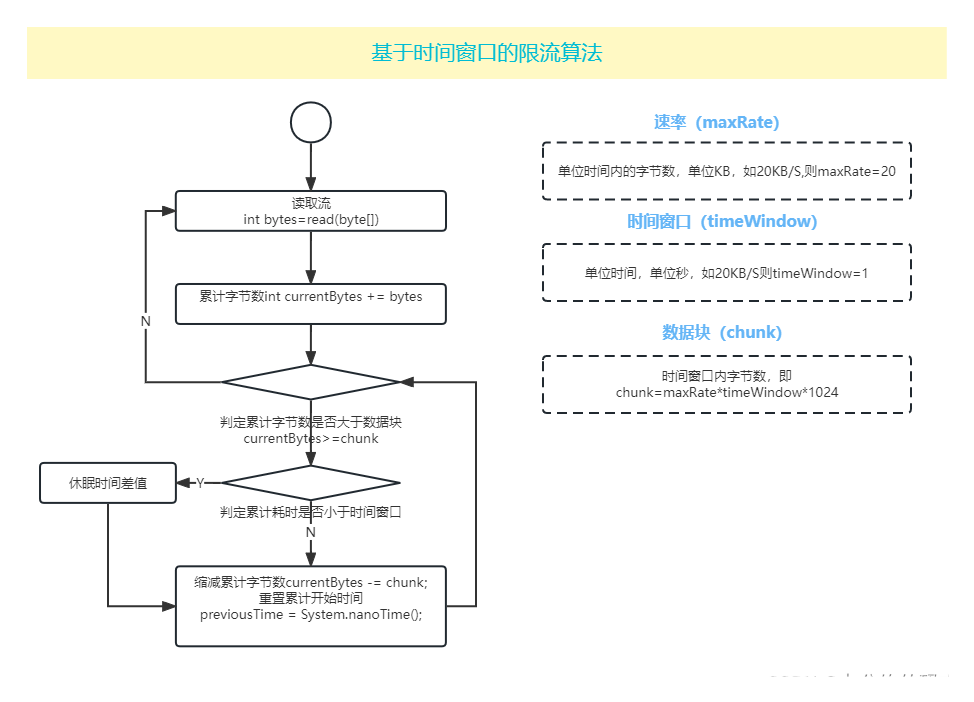Java基于时间窗口的限流算法
算法流程

CurrentLimiterInputStream
package com.liangzhm.io;
import java.io.BufferedInputStream;
import java.io.IOException;
import java.io.InputStream;
public class CurrentLimiterInputStream extends BufferedInputStream {
private static int DEFAULT_BUFFER_SIZE = 8192;
private CurrentLimiterVo streamLimitVo;
public CurrentLimiterInputStream(InputStream inputStream, CurrentLimiterVo streamLimitVo) {
this(inputStream, DEFAULT_BUFFER_SIZE, streamLimitVo);
}
public CurrentLimiterInputStream(InputStream inputStream, int size) {
this(inputStream, size, null);
}
public CurrentLimiterInputStream(InputStream inputStream, int size, CurrentLimiterVo streamLimitVo) {
super(inputStream, size);
this.streamLimitVo = streamLimitVo;
}
@Override
public int read(byte b[], int off, int len) throws IOException {
int bytes = super.read(b, off, len);
if (streamLimitVo != null) {
streamLimitVo.limit(bytes);
}
return bytes;
}
}
CurrentLimiterIoUtils
package com.liangzhm.io;
import org.springframework.util.StreamUtils;
import java.io.IOException;
import java.io.InputStream;
import java.io.OutputStream;
public class CurrentLimiterIoUtils {
public static void copy(InputStream in, OutputStream out, int maxRate) throws IOException {
copy(in, out, CurrentLimiterVo.of(maxRate));
}
public static void copy(InputStream in, OutputStream out, int maxRate, int timeWindow) throws IOException {
copy(in, out, CurrentLimiterVo.of(timeWindow, maxRate));
}
public static void copy(InputStream in, OutputStream out, CurrentLimiterVo currentLimiterVo) throws IOException {
StreamUtils.copy(new CurrentLimiterInputStream(in, currentLimiterVo), out);
}
}
CurrentLimiterVo
package com.liangzhm.io;
import java.util.concurrent.TimeUnit;
public class CurrentLimiterVo {
private static final int ONE = 1;
private static final int KB = 1024;
private static final int MILLION = 1000_000;
private long timeWindow;
private int chunk;
private long previousTime;
private int currentBytes = 0;
private int maxRate;
private CurrentLimiterVo(int maxRate) {
this(ONE, maxRate);
}
private CurrentLimiterVo(int timeWindow, int maxRate) {
if (timeWindow < 0) {
throw new RuntimeException("timeWindow不合法");
}
if (maxRate < 0) {
throw new RuntimeException("maxRate不合法");
}
this.maxRate = maxRate;
this.timeWindow = TimeUnit.SECONDS.toNanos(timeWindow);
this.chunk = this.maxRate * KB;
}
public static CurrentLimiterVo of(int maxRate) {
return new CurrentLimiterVo(maxRate);
}
public static CurrentLimiterVo of(int timeWindow, int maxRate) {
return new CurrentLimiterVo(timeWindow, maxRate);
}
public void limit(int bytes) {
if (bytes <= 0) {
return;
}
this.currentBytes += bytes;
if (this.previousTime == 0) {
this.previousTime = System.nanoTime();
}
while (this.currentBytes >= chunk) {
long passTime = System.nanoTime() - this.previousTime;
long missedTime = this.timeWindow - passTime;
if (missedTime > 0) {
try {
Thread.sleep(missedTime / MILLION, (int) (missedTime % MILLION));
} catch (InterruptedException e) {
}
}
this.currentBytes -= chunk;
this.previousTime = System.nanoTime();
}
}
}








 该代码实现了一个Java版的限流输入流,通过CurrentLimiterInputStream类限制读取数据的速度。CurrentLimiterIoUtils工具类提供了便捷的方法来复制输入流到输出流时进行限速。CurrentLimiterVo类用于配置限流参数,如最大速率和时间窗口。
该代码实现了一个Java版的限流输入流,通过CurrentLimiterInputStream类限制读取数据的速度。CurrentLimiterIoUtils工具类提供了便捷的方法来复制输入流到输出流时进行限速。CurrentLimiterVo类用于配置限流参数,如最大速率和时间窗口。














 651
651











 被折叠的 条评论
为什么被折叠?
被折叠的 条评论
为什么被折叠?








